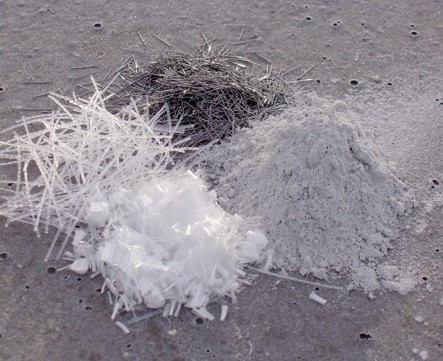UHPC Materials
Basic Raw Materials
Cement
The cements generally used for UHPC are CEM I low alkali Portland cements of strength classes 52.5, preferably with a high sulphate resistance These cements are advantageous because despite their high strength potential and despite the high cement content of fine-grained UHPC (700–850 kg/m3), the water requirement and the chemical shrinkage are limited and the possibility of an alkali-silica reaction is practically excluded.
Silica fume essentially functions physically as a micro filler. During UHPC heat treatment at approx. 80–90 °C it contributes partially to the formation of additional strength-forming hydrate phases. Owing to its large specific surface of 100 000 cm2/g and the high inter particle forces, silica fume is the main factor in the determination of water and super plasticizer requirements as well as the rheological properties of the fresh concrete.

Silica Fume
Silica fume essentially functions physically as a micro filler. During UHPC heat treatment at approx. 80–90 °C it contributes partially to the formation of additional strength-forming hydrate phases. Owing to its large specific surface of 100 000 cm2/g and the high inter particle forces, silica fume is the main factor in the determination of water and super plasticizer requirements as well as the rheological properties of the fresh concrete.
Inert Admixtures
Various fine quartz powders are used to achieve the optimum packing of the combination of particles. The important factor is that they should undergo highly selective fractionation. The powders act as fillers and partially reduce the granular gap of the cement.
Quartz powder exhibits high grain strength on the one hand and, on the other, is readily available in a wide range of well-defined gradings with different degrees of fineness.
Super plasticizers
Effective super plasticizers for UHPC are based on poly carboxylate ethers (PCE). Many different PCE super plasticizers are now available. However, most have to be optimized for their interaction with the different cements. Experience shows that for UHPC with a high quantity of silica fume, the super plasticizers that are particularly suitable are those that properly deagglomerate both the cement and the other fine particles.
Fibres
In Manufacturing, UniKrete Short, slender fibre with a diameter of max. 0.20 mm and length of 13–20mm made from high- strength steel with a tensile strength ≥2500 N/ mm2 results in a better workability of UHPC. Stainless Steel Fibers are used in some UHPC application as it provides higher tensile and flexural strength.
Corrosion-resistant high-strength synthetic fibre, from polyvinyl alcohol (PVA) are also commonly used. alkali resistant (AR) glass fibers and two layers of AR glass mesh fabrics are added to the process. The AR glass is the highest grade commercially available, manufactured with high zirconium content in compliance with ASTM C116/C. This fabric allows to maintain lowest cross sectional thickness with higher flexural strength. Fibers are especially tightly integrated into the very dense, solid and homogeneous microstructure of the fine – grained UHPC matrix. High bond stresses can therefore be transferred. On the other hand, the effect that the fibre have on increasing the ductility is based on the fact that when the matrix ruptures, the static friction between matrix and fibre is overcome without the fibre breaking themselves.
